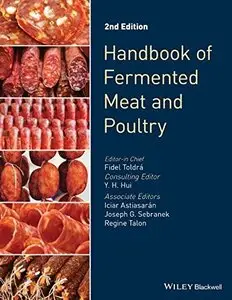Handbook of Fermented Meat and Poultry by Fidel Toldrá, Iciar Astiasaran, Joseph Sebranek, Regine Talon, Y. H. Hui
2015 | ISBN: 1118522699 | English | 528 pages | PDF | 9 MB
2015 | ISBN: 1118522699 | English | 528 pages | PDF | 9 MB
Fermented meat products have been consumed for centuries in many different parts of the world and constitute one of the most important groups of food. Bacterial cultures are used in their manufacture to preserve the meat and confer particular textures and sensory attributes. Examples of fermented meats include salami, chorizo, pepperoni and saucisson.
This fully revised and expanded reference book on meat fermentation presents all the principle fermented meat products and the processing technologies currently used in their manufacture. The 54 chapters of this substantial book are grouped into the following sections:
• Meat fermentation worldwide: overview, production and principles
• Raw materials
• Microbiology and starter cultures for meat fermentation
• Sensory attributes
• Product categories: general considerations
• Semidry-fermented sausages
• Dry-fermented sausages
• Other fermented meats and poultry
• Ripened meat products
• Biological and chemical safety of fermented meat products
• Processing sanitation and quality assurance
There are five new chapters in the second edition that address the following topics: Smoking and new smoke flavourings; Probiotics; Methodologies for the study of the microbial ecology in fermented sausages; Low sodium in meat products; and Asian sausages.
Handbook of Fermented Meat and Poultry, Second Edition provides readers with a full overview of meat fermentation, the role of microorganisms naturally present and/or added as starter cultures, safety aspects and an account of the main chemical, biochemical, physical and microbiological changes that occur in processing and how they affect final quality. Finally, readers will find the main types of worldwide fermented meat products, typically produced in different areas, with the description of their main characteristics.



